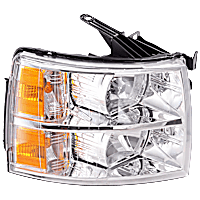Driving with a flickering headlight or headlights can create unsafe conditions on the road as they can create distractions not only for you but for other drivers as well.
If you’re wondering why your headlights and dash lights flicker when your car is running, you’re reading the right article. There are many reasons why your headlights may be flickering.
What Causes Flickering Headlights?
Generally, flickering headlights are caused by either a faulty bulb or a problem within the headlight circuit. If only one headlight is flickering, the type of headlights you have will determine the most sensible first step in diagnosis.
For a detailed, technical discussion about why flickering can happen in some headlights, read our explanation here. To learn the most likely reasons why your headlight keeps going out while driving, read below.
Failing Bulb
If you have halogen bulbs, the flickering may be caused by the filaments becoming damaged or worn out. But halogen headlights don’t often flicker that way – it’s possible, though, because if the filament is in two pieces, the ends of the broken filament can touch intermittently, which will cause a flicker, but that’s the exception rather than the rule.

There are different types of headlight bulbs, each with their own expected lifespan. Halogen headlights, which typically burn hot, usually have a shorter service life and will fail faster than others. If you have an older vehicle or even a newer, mid-priced model, you likely have halogen bulbs in your headlight assembly. That being said, it’s not unusual for halogen bulbs to literally last over 100,000 miles, so it’s not a foregone conclusion that you’ll ever see a flickering light or ever even have to replace one. They do fail, though; headlight bulbs can be easily bought from parts suppliers.
Higher-end vehicle models often come equipped with either light-emitting diodes (LEDs) or high-intensity discharge (HID) lights, which tend to last much longer. The issue with these is that they can have failures in the light itself causing them to be dim, and LED lights tend to flicker when they are near the end of their useful life.
Headlight Circuit Problem
Flickering headlights may also be caused by a circuit problem. For example, the issue can point to damaged wiring or a poor connection. A bad headlight switch or relay could also be to blame. (If you have a voltmeter and have enough DIY vehicle troubleshooting experience, you can try checking for voltage drop, which we explain here).
The headlight switch assembly on older vehicles includes a built-in circuit breaker, and when a short circuit occurs, it can cause the headlights to flicker, but that won’t cause just one of the headlights to flicker or flash off and on – they’ll both be doing the same thing.
This is why flickering headlights used to be a bit more common with older models, but the headlight switch circuit breaker usually lasts the life of the vehicle.
Weak Battery
Your car battery will usually give you signs when it is nearing the end of its life—one of them may be flickering headlights. A weak battery may not give out enough power for your headlights, causing them to go dim or flicker. Of course, in that case, you’ll notice other issues before you notice flickering headlights. But a diagnosis of any electrical issue on your vehicle should begin with an inspection of the battery terminals and a test of the battery itself.
Generally, car batteries can last around three to five years. However, there are several factors that can affect your battery’s lifespan, such as your vehicle’s condition, your driving habits, or the weather conditions where you live.

Loose Connections
If your headlights still flicker after changing your battery, then you might be dealing with a loose connection. Your car’s electrical systems are made up of complex connections and a series of fuses that can become faulty or loose over time. Driving through bumpy and rough roads can lead to loose connections. So if you’ve recently gone off-road or we’re on a trip out of town, you might be facing this type of issue.
NOTE: Never do any kind of work (including jump-starting) around the battery on a vehicle without good eye protection that goes beyond your regular eyeglasses. Have some new safety glasses on hand like the ones that go over your regular eyeglasses – you need the protection, because eye damage is permanent, and batteries can explode. Even if you’ve never seen this happen, it does happen.
Failing Alternator
An issue with the alternator (or the voltage regulator, which is often located inside the alternator) can cause the headlights to flicker. Such charging system problems may lead to inconsistent current output, which can cause your headlights to flicker.
If this component is to blame, you will likely observe a few other common symptoms that point to a bad alternator.
It is important to diagnose the problem right away, so you or your mechanic can fix your flickering headlights as soon as possible. If you do not have the technical know-how or DIY skills to resolve the issue, it is best to leave this job to a professional.
Why Is My Headlight Flickering Along With My Dash Lights?
Driving at night with flickering headlights and dashboard lights can be dangerous. The most common culprit is a dying battery.
If your battery was recently recharged or replaced, a malfunctioning ignition switch or alternator could be causing the problem. Mixed up battery connections, low-quality spare parts, and corroded connectors may cause these components to malfunction.
The issue could also stem from loose, stripped, or cut connections. Have a mechanic check your headlight and dashboard light wiring.
Diagnosing Your Headlights
As discussed previously, flickering headlights can be caused by one of several potential causes. Once you’ve ruled out the battery and the alternator, here are other ways to diagnose your flickering headlight problem:
Visual Inspection
The first step is to perform a visual inspection. Look for issues, such as:
- Damaged wiring
- Burnt out headlight bulb(s)
- Damaged headlight socket(s)
- Loose electrical connections

Using a Scan Tool
If you have the DIY skill and a factory or factory-level scan tool, you can diagnose a broken headlight by following these steps:
- Using your scan tool, turn your headlights on using the bi-directional command. If they do turn on, this means the problem does not lie in your headlight circuit. The problem is most likely associated with the control input to the specific controller that controls the headlight.
- Pinpoint the location of the open circuit by checking the voltage at different parts using the schematic for the headlight circuit. For this step, make sure to always follow your repair manual.
- If your headlights appear brighter than normal, the problem may be related to a high battery voltage. If only ONE of the headlights is brighter than normal, that headlight is beginning to fail. Check the charging system voltage and make sure that it is less than 15.5 volts, which is the standard for most vehicles. You can check the service information to find out the exact specification.
- If your headlights are dimmer than usual, this can be a sign that there is excessive circuit resistance, such as a loose electrical connection, a corroded socket, or poor electrical ground connection. That’s when you perform the voltage drop test described here.
Flickering headlights can cause accidents on the road. Usually though, flickering headlights are just annoying. If you notice that your headlights are not working properly, do not waste time and address the issue right away. You and your passengers’ safety should always come first.
Circuit Breakers and Flickering Headlights
To have your headlights suddenly go completely out while you’re driving at night can be terrifying at best and catastrophic at worst. So, for that reason, headlights on older vehicles have a self-resetting circuit breaker built into the headlight switch to prevent a total sudden loss of the headlights if possible.
On those older vehicles (1960s through the early 1990s) if a short to ground happens on a wire leading to one of the headlights, the switch’s internal circuit breaker will open the circuit, close it, reopen it, close it again, and so on, so that the side that doesn’t have a short, that headlight will flash off and on continually to provide enough illumination to either get to a safe place or get off the road.
But if both headlights are flashing this way rather than just one of the headlights, it typically means the circuit breaker in the switch has aged to the point that it can’t handle normal headlight amperage and the headlight switch needs to be replaced. Typically this kind of failure will only happen after the lights have been on for a while, because that heats the faulty circuit breaker to the point that it begins cycling. But it’s not hard to duplicate. Just pay attention to how long you drive before it begins to happen each time – and if the circuit breaker in the switch is failing, it’ll happen on every drive.
Newer vehicles may have a circuit breaker external to the switch, but usually they have a separate fuse for each filament of each headlight bulb, i.e., four filaments (2 bright, 2 dim), and four fuses, one for each filament. That way if a short occurs in a wire leading to one of the filaments, the rest of the filaments will still work.
How to Check Flickering Headlights for Voltage Drop
The principle of “voltage drop” is familiar to mechanics, but not so familiar to people who don’t do electrical work. Most people know that if you connect a voltmeter to your battery, you’ll read 12 volts. But if you touch one probe to the battery post and the other to the terminal connected to that post, you shouldn’t read any voltage at all. That seems like a no-brainer. But if you have current flowing (lights on, spinning the starter, etc.) while you’re taking that measurement, any corrosion or resistance between the battery terminal and the battery post will show a voltage reading – and that’s lost voltage – which indicates a bad connection. Granted, this is a difficult test to do on a GM side-post battery.
But you can also test a dim or flickering headlight this way if you can access the wiring, by checking for voltage drop between the positive battery terminal and the wire feeding voltage to the dim headlight. If, for example, you read 3 volts between the positive battery terminal and the wire at the headlight on a 12 volt system (engine not running), that headlight will only be receiving 9 volts instead of 12. You can also perform this test from the battery ground terminal to the headlight ground wire at the bulb – because voltage drop on the ground side can also cause the headlight not to receive all the voltage it needs.
The problem is that you’re measuring voltage drop on the entire circuit and you won’t know where the voltage is being lost – you’ll just know there’s resistance somewhere in the circuit feeding that light. But usually where there’s resistance, there’s heat, so look for discoloration or melting at connectors on that circuit. Also, if you watch the headlights while gently manipulating connectors (either at the light itself or at another connector on the circuit) and see that the lights change intensity or stop flickering while you’re toying with the connectors, you’ve found where the problem is. Repair accordingly, but do it right.
A caveat is that if the voltage drop is between the headlight bulb blade and the headlight wire terminal, the voltage drop test described above won’t show it – but unplugging the headlight and examining the terminals will show signs of heat and oxidation, and parts suppliers sell replacement headlight switch pigtails for that reason.
In that case, it’s best to replace the bulb along with the pigtail, but make sure you do a good job splicing the new pigtail in (soldering is best, followed by some good heat shrink insulation at the splice). If you do a sloppy job installing the pigtail, you’ll still have flickering headlights when the wires you tied and taped begin to lose connection – and usually they will. Again, take your time and do it right.
Products Mentioned in this Guide
Any information provided on this Website is for informational purposes only and is not intended to replace consultation with a professional mechanic. The accuracy and timeliness of the information may change from the time of publication.


 Headlight
Headlight
 Alternator
Alternator
 Battery
Battery




























